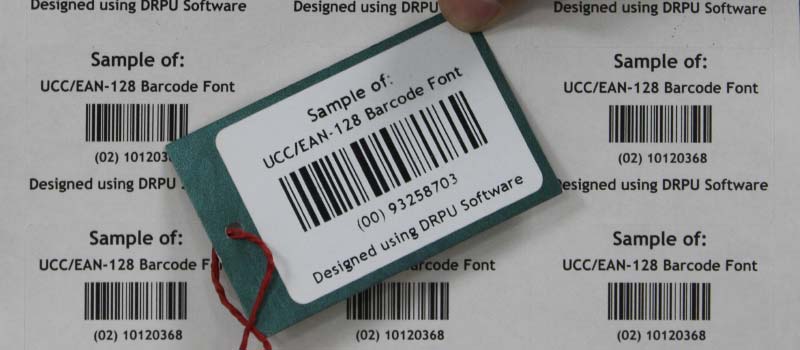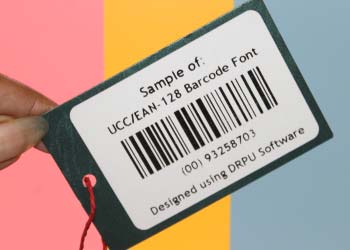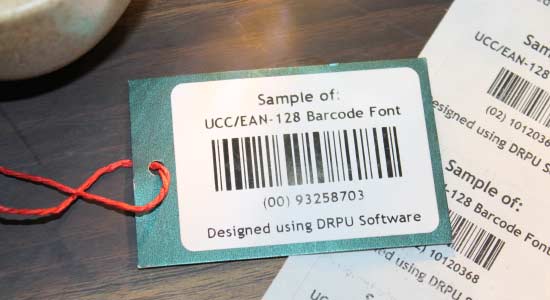Posted By: Tech Solution | Last Updated On:
Introduction of UCC/EAN-128 Barcode
- The UCC/EAN-128 barcode is typically used in logistics and supply chain management applications, where it is used to encode information such as product numbers, batch numbers, expiry dates, and other data related to product tracking and inventory management. It can also be used to encode other types of data, such as customer information, shipping information, and purchase order numbers.
- The UCC/EAN-128 barcode is similar to other barcode symbologies in that it consists of a series of bars and spaces that represent encoded data. However, it differs in its structure and the types of data it can encode. The barcode is composed of several different elements, including a start code, application identifier (AI), data, and a check digit.
- The start code, also known as the "quiet zone," is a blank space that precedes the barcode and is used to help scanners locate and read the barcode. The application identifier is a two- or three-digit number that indicates the type of data being encoded, such as a product number or batch number. The data element contains the actual information being encoded, which can be alphanumeric or numeric. The check digit is used to verify the accuracy of the encoded data and ensure that the barcode is read correctly.
- One of the key advantages of the UCC/EAN-128 barcode is its flexibility in terms of the types of data it can encode. The use of application identifiers allows for the encoding of a wide range of data types, including date and time stamps, weights and measures, and serial numbers. Additionally, the barcode can be easily integrated with other supply chain management systems, such as RFID and electronic data interchange (EDI) systems.
- The UCC/EAN-128 barcode is widely used in the retail industry, where it is used to track inventory, manage stock levels, and ensure accurate pricing and billing. It is also used in healthcare applications, where it is used to encode patient and medication information for tracking and inventory management purposes. Other industries that use the UCC/EAN-128 barcode include manufacturing, transportation, and logistics.
Summary: The UCC/EAN-128 barcode is a linear barcode symbology that is used to encode a variety of data types in a standardized format. It is based on the Code 128 symbology and is part of the GS1 system. The barcode is composed of several elements, including a start code, application identifier, data, and check digit. Its flexibility and compatibility with other supply chain management systems make it a popular choice in a wide range of industries.
Structure of a UCC/EAN-128 Barcode
The UCC/EAN-128 barcode, also known as GS1-128 or EAN-128, is a linear, variable-length symbology that encodes data using a combination of Application Identifier (AI) and data fields. The barcode structure consists of three parts: the start character, the data encoded using AI and data fields, and the stop character.

The start character of the UCC/EAN-128 barcode is usually the Code 128 start character. It is followed by an AI, which is a two, three, or four-digit number that indicates the type of data that follows. The AI is used to identify the data field and its length. For example, AI 01 indicates that the data field contains a GTIN (Global Trade Item Number), and its length is 14 digits.
After the AI, the data field follows, which contains the actual data to be encoded in the barcode. The length of the data field is determined by the AI. If the AI indicates a fixed length, the data field will be of that length. If the AI indicates a variable length, the length of the data field can vary.
In addition to the AI and data fields, the UCC/EAN-128 barcode also allows for optional check digits to be included. Check digits can be used to verify the accuracy of the data encoded in the barcode. The stop character of the UCC/EAN-128 barcode is usually the Code 128 stop character. It signals the end of the barcode and indicates that the scanner should stop reading the barcode.
Conclusion: The UCC/EAN-128 barcode structure provides a flexible and efficient way to encode a wide range of data types and lengths.
Applications of UCC/EAN-128 Barcode
The UCC/EAN-128 barcode, also known as GS1-128, is a widely used barcode format that is used in many industries, including retail, healthcare, transportation, and logistics. Its ability to encode a large amount of data in a single barcode, as well as its compatibility with other GS1 standards, makes it a versatile and powerful tool for supply chain management and inventory tracking.
Here are some of the main applications of UCC/EAN-128 barcode:
-
Product Identification:
UCC/EAN-128 barcode is used to uniquely identify products in the retail industry. Each barcode contains a Global Trade Item Number (GTIN) that is assigned to the product by the manufacturer. Retailers can use this information to track inventory, manage stock levels, and improve supply chain efficiency.
-
Serial Number Tracking:
UCC/EAN-128 barcode can be used to track individual items within a larger shipment. By encoding serial numbers in the barcode, manufacturers and retailers can quickly and accurately identify specific products and track their movements through the supply chain.
-
Healthcare:
UCC/EAN-128 barcode is used extensively in the healthcare industry to improve patient safety and streamline medical processes. The barcode can be used to identify patients, track medical devices and equipment, and ensure that the right medication is given to the right patient at the right time.
-
Transportation and Logistics:
UCC/EAN-128 barcode is used to track shipments and packages as they move through the supply chain. By encoding information such as the origin and destination of the shipment, the carrier, and the contents of the package, UCC/EAN-128 barcode helps to ensure that packages are delivered to the correct location on time.
-
Warehouse Management:
UCC/EAN-128 barcode is used in warehouses and distribution centers to track inventory and manage stock levels. By encoding information such as the location and quantity of each item, the barcode helps to ensure that products are stored and shipped efficiently, reducing the risk of overstocking or stockouts.
-
Electronic Data Interchange (EDI):
UCC/EAN-128 barcode is used to exchange information electronically between trading partners in the supply chain. By encoding information such as purchase order numbers, shipping information, and product details in the barcode, trading partners can exchange information quickly and accurately, reducing errors and improving supply chain efficiency.
Overall, UCC/EAN-128 barcode is a versatile and powerful tool that is used extensively in many industries to improve supply chain efficiency and inventory management. Its ability to encode a large amount of data in a single barcode makes it an ideal choice for businesses that need to track and manage inventory across multiple locations and supply chain partners.
Minimum and Maximum Length of a UCC/EAN-128 Barcode
The UCC/EAN-128 barcode is a variable-length, high-density barcode that can encode a large amount of information. The minimum and maximum length of a UCC/EAN-128 barcode depend on the type of data being encoded and the application.

-
In general, the UCC/EAN-128 barcode can be between 2 and 48 characters long, although it can be longer in some cases. The barcode is made up of a series of data elements, each of which has a specific format and length.
-
The first data element is the Application Identifier (AI), which indicates the type of data being encoded. The AI is always enclosed in parentheses and is followed by the data to be encoded. The length of the data element depends on the specific AI being used.
-
For example the AI 01 is used to encode a Global Trade Item Number (GTIN). The GTIN is a 14-digit number used to identify products and is used in retail environments. The AI 01 is always followed by a 14-digit GTIN.
-
The AI 10 is used to encode a batch or lot number. The length of the batch or lot number can vary, but it cannot exceed 20 characters. The AI 10 is always followed by the batch or lot number.
-
The AI 21 is used to encode a serial number. The length of the serial number can vary, but it cannot exceed 20 characters. The AI 21 is always followed by the serial number.
-
In addition to these data elements, the UCC/EAN-128 barcode can also include a number of other optional elements, such as date and time stamps, quantities, and locations.
Overall, the length of a UCC/EAN-128 barcode can vary widely depending on the specific data being encoded and the needs of the application. However, the barcode is designed to be highly flexible and adaptable, allowing it to encode a wide range of information in a compact and efficient format.
Difference Between UCC/EAN-128 Barcode and other Barcode
The UCC/EAN-128 barcode is a specific type of barcode that is used in supply chain management and logistics. It is different from other barcode types in several ways, including its structure, the data it can store, and the industries in which it is used.
-
Structure:
The UCC/EAN-128 barcode has a specific structure that is based on the Code 128 barcode standard. This means that it can encode a large amount of data in a relatively small space. The barcode is made up of several elements, including start and stop characters, data characters, and check characters. The start and stop characters indicate the beginning and end of the barcode, while the data characters represent the information being encoded. The check characters are used to ensure the accuracy of the data.
-
Industries:
The UCC/EAN-128 barcode is used primarily in the retail, healthcare, and automotive industries. In the retail industry, it is used to track products from the manufacturer to the retailer, and to facilitate inventory management and replenishment. In the healthcare industry, it is used to track medical supplies and equipment, and to ensure that medications are administered correctly. In the automotive industry, it is used to track parts and components from the manufacturer to the assembly line.
-
Data storage:
One of the main differences between the UCC/EAN-128 barcode and other barcode types is the amount of data it can store. The UCC/EAN-128 barcode can encode not only product information, but also information about the manufacturer, packaging, and shipping. This makes it an ideal choice for supply chain management and logistics, where it is important to track products from the manufacturer to the end consumer.
Summary: The UCC/EAN-128 barcode is a specialized barcode type that is designed for use in supply chain management and logistics. Its structure, data storage capacity, and industry applications make it different from other barcode types.
